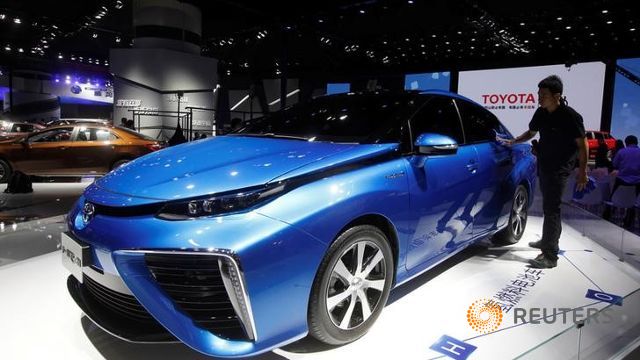Toyota to recall all 2,800 Mirai fuel cell cars on the road
 |
| A Mirai fuel cell vehicle by Toyota is displayed at China (Guangzhou) International Automobile Exhibition in Guangzhou, China November 18, 2016. photo source: REUTERS/Bobby Yip |
Toyota said that under unique driving conditions, such as if the accelerator pedal is depressed to the wide open throttle position after driving on a long descent while using cruise control, there was a possibility the output voltage generated by the fuel cell boost converter could exceed the maximum voltage.
To date, Toyota has sold about 2,840 Mirai cars in Japan, the United States and some markets in Europe, as well as the United Arab Emirates.
Toyota dealers will update the fuel cell system software at no cost to the customer, it said. The process will take about half an hour, it said.
Toyota first began selling the hydrogen-fueled Mirai in December 2014 in Japan, its home market, in a bid to lead the industry in the nascent technology. Toyota has promoted fuel cell vehicles as the most sensible next-generation option to hybrids, although a lack of hydrogen fuelling stations remains a major hurdle for mass consumption.
What the stars mean:
★ Poor ★ ★ Promising ★★★ Good ★★★★ Very good ★★★★★ Exceptional
Latest News
More News
- Energy efficiency in buildings tops organisations’ infrastructure priorities (December 11, 2025 | 10:40)
- How smart infrastructure and digitalisation power the systemic transition (December 11, 2025 | 10:00)
- Lawmakers split over VAT on fertilisers and animal feed (December 10, 2025 | 18:56)
- Kim Long deal marks turning point for Vietnam’s auto industry (December 10, 2025 | 18:44)
- Pernod Ricard Vietnam supports flood-hit localities (December 10, 2025 | 14:18)
- SABECO honoured at Vietnam M&A Forum for outstanding deal of 2024-2025 (December 10, 2025 | 12:00)
- Vietnam raises taxable revenue threshold for household businesses to VND500 million (December 10, 2025 | 11:34)
- Vietnam M&A Forum 2025: new position, new momentum (December 09, 2025 | 14:30)
- Masan Consumer reveals HSX listing roadmap (December 09, 2025 | 14:09)
- Industrial sector posts robust gains as year-end demand rises (December 09, 2025 | 13:38)


















 Mobile Version
Mobile Version